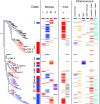Analysis of genetic relatedness of Haemophilus influenzae isolates by multilocus sequence typing
- PMID: 18065541
- PMCID: PMC2238191
- DOI: 10.1128/JB.01207-07
Analysis of genetic relatedness of Haemophilus influenzae isolates by multilocus sequence typing
Abstract
The gram-negative bacterium Haemophilus influenzae is a human-restricted commensal of the nasopharynx that can also be associated with disease. The majority of H. influenzae respiratory isolates lack the genes for capsule production and are nontypeable (NTHI). Whereas encapsulated strains are known to belong to serotype-specific phylogenetic groups, the structure of the NTHI population has not been previously described. A total of 656 H. influenzae strains, including 322 NTHI strains, have been typed by multilocus sequence typing and found to have 359 sequence types (ST). We performed maximum-parsimony analysis of the 359 sequences and calculated the majority-rule consensus of 4,545 resulting equally most parsimonious trees. Eleven clades were identified, consisting of six or more ST on a branch that was present in 100% of trees. Two additional clades were defined by branches present in 91% and 82% of trees, respectively. Of these 13 clades, 8 consisted predominantly of NTHI strains, three were serotype specific, and 2 contained distinct NTHI-specific and serotype-specific clusters of strains. Sixty percent of NTHI strains have ST within one of the 13 clades, and eBURST analysis identified an additional phylogenetic group that contained 20% of NTHI strains. There was concordant clustering of certain metabolic reactions and putative virulence loci but not of disease source or geographic origin. We conclude that well-defined phylogenetic groups of NTHI strains exist and that these groups differ in genetic content. These observations will provide a framework for further study of the effect of genetic diversity on the interaction of NTHI with the host.
Figures




Similar articles
-
Capsule gene analysis of invasive Haemophilus influenzae: accuracy of serotyping and prevalence of IS1016 among nontypeable isolates.J Clin Microbiol. 2007 Oct;45(10):3230-8. doi: 10.1128/JCM.00794-07. Epub 2007 Aug 15. J Clin Microbiol. 2007. PMID: 17699642 Free PMC article.
-
Phylogenetic relatedness and diversity of non-typable Haemophilus influenzae in the nasopharynx and middle ear fluid of children with acute otitis media.J Med Microbiol. 2011 Dec;60(Pt 12):1841-1848. doi: 10.1099/jmm.0.034041-0. Epub 2011 Jul 28. J Med Microbiol. 2011. PMID: 21799196 Free PMC article.
-
Population structure in nontypeable Haemophilus influenzae.Infect Genet Evol. 2013 Mar;14:125-36. doi: 10.1016/j.meegid.2012.11.023. Epub 2012 Dec 22. Infect Genet Evol. 2013. PMID: 23266487 Free PMC article.
-
Host-pathogen interactions of nontypeable Haemophilus influenzae: from commensal to pathogen.FEBS Lett. 2016 Nov;590(21):3840-3853. doi: 10.1002/1873-3468.12351. Epub 2016 Aug 25. FEBS Lett. 2016. PMID: 27508518 Review.
-
Nontypeable Haemophilus influenzae: understanding virulence and commensal behavior.Trends Microbiol. 2007 Aug;15(8):355-62. doi: 10.1016/j.tim.2007.06.004. Epub 2007 Jun 27. Trends Microbiol. 2007. PMID: 17600718 Review.
Cited by
-
Panel 5: Microbiology and immunology panel.Otolaryngol Head Neck Surg. 2013 Apr;148(4 Suppl):E64-89. doi: 10.1177/0194599812459636. Otolaryngol Head Neck Surg. 2013. PMID: 23536533 Free PMC article. Review.
-
Genomic characterization of Haemophilus influenzae: a focus on the capsule locus.BMC Genomics. 2019 Oct 12;20(1):733. doi: 10.1186/s12864-019-6145-8. BMC Genomics. 2019. PMID: 31606037 Free PMC article.
-
Diversity of nontypeable Haemophilus influenzae strains colonizing Australian Aboriginal and non-Aboriginal children.J Clin Microbiol. 2014 May;52(5):1352-7. doi: 10.1128/JCM.03448-13. Epub 2014 Feb 5. J Clin Microbiol. 2014. PMID: 24501028 Free PMC article.
-
Prevalence, distribution, and sequence diversity of hmwA among commensal and otitis media non-typeable Haemophilus influenzae.Infect Genet Evol. 2014 Dec;28:223-32. doi: 10.1016/j.meegid.2014.09.035. Epub 2014 Oct 5. Infect Genet Evol. 2014. PMID: 25290952 Free PMC article.
-
Otitis media associated polymorphisms in the hemin receptor HemR of nontypeable Haemophilus influenzae.Infect Genet Evol. 2014 Aug;26:47-57. doi: 10.1016/j.meegid.2014.05.002. Epub 2014 May 10. Infect Genet Evol. 2014. PMID: 24820341 Free PMC article.
References
-
- Augustynowicz, E., A. Gzyl, L. Szenborn, D. Banys, G. Gniadek, and J. Slusarczyk. 2003. Comparison of usefulness of randomly amplified polymorphic DNA and amplified-fragment length polymorphism techniques in epidemiological studies on nasopharyngeal carriage of non-typable Haemophilus influenzae. J. Med. Microbiol. 521005-1014. - PubMed
-
- Bolduc, G. R., V. Bouchet, R. Z. Jiang, J. Geisselsoder, Q. C. Truong-Bolduc, P. A. Rice, S. I. Pelton, and R. Goldstein. 2000. Variability of outer membrane protein P1 and its evaluation as a vaccine candidate against experimental otitis media due to nontypeable Haemophilus influenzae: an unambiguous, multifaceted approach. Infect. Immun. 684505-4517. - PMC - PubMed
-
- Cardines, R., M. Giufre, P. Mastrantonio, M. L. Ciofi degli Atti, and M. Cerquetti. 2007. Nontypeable Haemophilus influenzae meningitis in children: phenotypic and genotypic characterization of isolates. Pediatr. Infect. Dis. J. 26577-582. - PubMed
Publication types
MeSH terms
Substances
Associated data
- Actions
- Actions
- Actions
Grants and funding
LinkOut - more resources
Full Text Sources
Molecular Biology Databases

